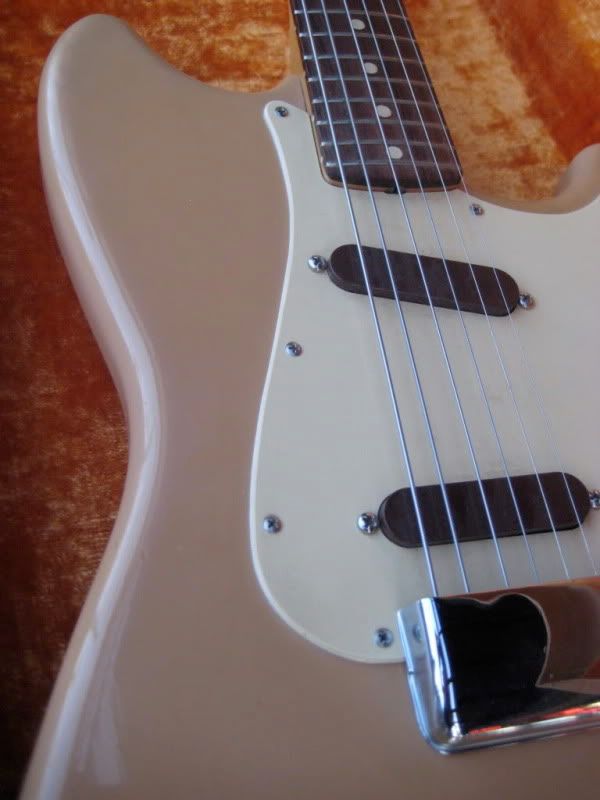Postby twango the clown » Mon Apr 26, 2010 10:53 pm
Hey! I had one of those for years! It was already a parts guitar when I bought the basic parts for $145.00 (the exact amount of my tax return) from Eric Rosenfeld in 1978.
I was in the repair shop of the Record Garage in Cambridge, (lovingly referred to as the Wreckage Garage,) purveyors of spiffed-up parts guitars sold as the real thing, as well as parts despoilers of vintage guitars in for repairs, (don't trust those pots codes boys, they've been at it for a long time!) when I saw a maple Duosonic neck sticking out of the necks leaning in the corner. Further rummaging yielded a body, inexpertly refinished in already-disintegrating sunburst, and the 'gold' anodized pickguard assembly with no pickups and a slide switch on the treble bout. I also found the chocolate-colored pickup covers, but no pickups. The stock bridge was on the body, hanging by one screw. Eric swapped them for my check.
The maple neck was beautiful; a fifties maple Fender neck thin as a spindle, with wear grooves all up the fretboard. It was 3/4 scale length,and a warm golden orange. Had to have it.
But there was no way for me to make it stock. Inside of the pickup cavities there were signs of the original color, but I thought it was some kind of primer.There appeared to be no ground wire, apparently unnecessary as the metal pickguard touched both the tailpiece and the electronics. I had gotten a hold of two old Strat staggered pole pickups while rousing through the huge drawer full of parts, and put them in.
I got it refinished in Chevy Truck Blue as Eddie Murray called it, and put an SG toggle switch instead of the slide switch.
The result was quite presentable, I thought. The bright blue, about the color of Johnny Ramone's guitar, went well with the gold pickguard. On those short-scale necks you can do fantastic stretches and fast runs.
As a stage guitar (it played many, many shows back in the day) it had a few shortcomings.
No three-quarter is ever going to deliver the tone like a full scale. Onstage, they sound like they have a cold. You can learn to live in the cramped space on the neck, (I liked it,) but they're harder to tune and hard to keep in tune.
That said, they're a blast to flip around and do tricks on. They're So Cute and they make you try things that would not occur to you in a bigger neck.
Years later, I traded it to Cambridge Music Center for a copper-colored Danelectro I wanted. They told me that the staggered-pole strat pickups were worth more than the whole guitar. Who knew? I had picked them at random from the junk drawer.
One aspect of this guitar never occurred to me until it was too late.
My son, 13, of whom I had no idea was interested in guitar, said to me, "What happened to the blue guitar?" I told him. His face crumpled.
"You ruin everything!" he said.
Don't sell your Duo's, boys.


